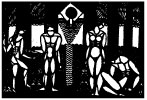|
|
| |
Barbarians
by Rita Wellman
|
| |
Ivan’s Homecoming opened the Seventh Bill on February 16, 1917, and the play that followed it on this “war” bill was Barbarians by Rita Wellman. Like Ivan’s Homecoming, there is no extant script of this play. Kenton, however, remembers that with Barbarians they were aware they were “rehearsing a sure fire hit,” and doing so with a particular “ease” that they “marveled” at with Nina Moise at the helm.(1) In another account, Kenton calls it “one of the timeliest, cleverest, little comedies we ever laid our hands on.”(2) By all descriptions, the play seems to have been more “ironic” than an out-an-out comedy, exposing “anti-German hysteria” by depicting three women in a war-ravaged village who find three kind and considerate soldiers of the invading army, with the play subverting “gender as well as ethnic stereotypes.”(3) Moise, who directed, and Rauh, who played the lead, each remember the exciting possibility of being arrested for saying “goddamn” onstage (which they weren’t), Moise believing they were the first to ever say it on a New York stage.(4) Ida Rauh, who played the lead role of Marta, elaborated on the plot in an interview with Sarlos in 1964:
Three women lived in a house, somewhere I think in Belgium, and three German soldiers were quartered with them. Marta, the oldest of the three girls, whom I have played, tried to seduce the soldiers one after the other. But they were too proper and polite to be seduced, and the play was funny all the way through. Finally, as the soldiers leave the house, Marta says, “Barbarians!”(5)
Gold remembers thinking when he saw the play, “When does the raping begin?”(6) Pendleton King played the first soldier and Nancy Schoonmaker played a character named Mrs. Peters (perhaps the three girls’ mother). The other four actors were new to the Players: Luie Erle as Sonia, Dorothy Upjohn (daughter of Dr. William Upjohn, founder of the pharmaceutical giant) as Lisa, and Morton Stafford and Theron M. Bamberger as the Second and Third “Barbarians.”
This was Rita Wellman’s first play to be presented by the Players and this production is the first mention of her involvement with them. Born in Washington DC in 1890, she was the only child from the first marriage of famed journalist and arctic explorer William Wellman, who founded the Cincinnati Post and later was the Washington correspondent for the Chicago Herald (and its successor, the Chicago Record-Herald).(7) Her involvement with the Players may have come through her long-standing friendship with painter Charles Demuth, with whom she attended the Pennsylvania Academy of Fine Arts sometime between 1905 and 1910. She described their time there together when she wrote a tribute to Demuth in 1931:
We were students together when we were very young. When we were very young, we were very old. We were all bored with life; knew everything there was to know, and only condescended to give our time and talents to painting because it seemed to our jaded spirits the one respectable calling left.(8)
While attending the art academy, knowing already that Demuth’s tremendous talent outclassed her, she recalled one of their teachers, Henry McCarter, kindly critiquing one of her works by asking, “Do you ever try to write stories?”(9) Wellman was to become one of most produced woman playwrights of the Players, third after Glaspell and Boyce. She also became the first of any of the Provincetown playwrights to be subsequently produced on Broadway: her play The Gentile Wife opened on December 24, 1918 to very favorable reviews, with the play’s three settings designed by Robert Edmond Jones.(10)
© Jeff Kennedy, 2007.
(2)Kenton 53.
(4) Black, Women 60; Sarlos, Provincetown 126-127.
(5) Sarlos, Provincetown 126.
(6) Sarlos, Provincetown 126.
(7) Walter Wellman (1858-1934) was also famed for attempting to fly across the Atlantic in 1910 in a dirigible called America, though the flight failed and the crew landed in the ocean near Bermuda. He remarried, having three children, and continued to write for a few years before disappearing from public eye until his death in 1934. See Time (February 12, 1934):10-11 and New York Times (February 1, 1934): 19.
(8) Rita Wellman, “Pen Portraits” Creative Art, December 1931, reprinted in Letters, 167.
(9) Rita Wellman, “Pen Portraits” Creative Art, December 1931, reprinted in Letters, 168.
(10) Sometime before 1921, Wellman married Edgar J. Leo, ten years her senior, a stock broker and semi-pro tennis player whose removal from his seat on the Stock Exchange in 1906 began a life filled with financial problems and gambling that were played out in the New York newspapers. On September 9, 1930, the New York Times reported that Leo committed suicide with a bullet to the head, describing that “about him were unpaid bills and a sealed envelope containing a slip of paper bearing the name of his wife . . . and the telephone number of her apartment,” but also reports that he and Wellman “had been separated several years” (New York Times, 9 Sept. 1930).
|
| |
|
|
|
